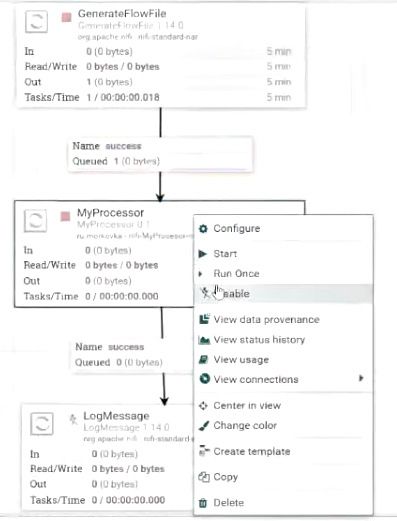This content originally appeared on HackerNoon and was authored by Temirlan Amanbayev
\ Apache NiFi is a powerful tool for automating data flows with a large number of built-in processors. However, sometimes there is a need for specific processors to handle unique requirements and data stores. In such cases, creating custom processors becomes a necessity. In this article, we will go through the steps to create a very simple custom processor for Apache NiFi.
\
Setup and sources
gradle setup
dependencies {
compile "org.apache.nifi:nifi-api:*"
compile "org.apache.nifi:nifi-utils:1.9.2"
testCompile "org.apache.nifi:nifi-mock:1.9.2"
}
\ source of the custom processor
import org.apache.nifi.annotation.behavior.ReadsAttribute;
import org.apache.nifi.annotation.behavior.ReadsAttributes;
import org.apache.nifi.annotation.behavior.WritesAttribute;
import org.apache.nifi.annotation.behavior.WritesAttributes;
import org.apache.nifi.annotation.documentation.CapabilityDescription;
import org.apache.nifi.annotation.documentation.SeeAlso;
import org.apache.nifi.annotation.documentation.Tags;
import org.apache.nifi.annotation.lifecycle.OnScheduled;
import org.apache.nifi.components.PropertyDescriptor;
import org.apache.nifi.expression.ExpressionLanguageScope;
import org.apache.nifi.flowfile.FlowFile;
import org.apache.nifi.processor.*;
import org.apache.nifi.processor.exception.ProcessException;
import org.apache.nifi.processor.util.StandardValidators;
import java.io.OutputStream;
import java.nio.charset.StandardCharsets;
import java.util.*;
@Tags({"example"})
@CapabilityDescription("Hello World to output")
@SeeAlso({})
@ReadsAttributes({@ReadsAttribute(attribute = "", description = "")})
@WritesAttributes({@WritesAttribute(attribute = "", description = "")})
public class MyProcessor extends AbstractProcessor {
public static final PropertyDescriptor propertyDescriptor = new PropertyDescriptor
.Builder().name("name")
.displayName("name")
.description("Name to print")
.required(true)
.addValidator(StandardValidators.NON_EMPTY_VALIDATOR)
.expressionLanguageSupported(ExpressionLanguageScope.FLOWFILE_ATTRIBUTES)
.build();
public static final Relationship successRelations = new Relationship.Builder()
.name("success")
.description("If everything is ok")
.build();
public static final Relationship failureRelations = new Relationship.Builder()
.name("failure")
.description("If something is wrong")
.build();
private List<PropertyDescriptor> descriptorList;
private Set<Relationship> relationshipSet;
@Override
protected void init(final ProcessorInitializationContext context) {
final List<PropertyDescriptor> descriptors = new ArrayList<PropertyDescriptor>();
descriptors.add(propertyDescriptor);
this.descriptorList = Collections.unmodifiableList(descriptors);
final Set<Relationship> relationships = new HashSet<Relationship>();
relationships.add(successRelations);
relationships.add(failureRelations);
this.relationshipSet = Collections.unmodifiableSet(relationships);
}
public Set<Relationship> getRelationshipSet() {
return this.relationshipSet;
}
@Override
public final List<PropertyDescriptor> getSupportedPropertyDescriptors() {
return descriptorList;
}
@OnScheduled
public void onScheduled(final ProcessContext context) {
}
@Override
public void onTrigger(final ProcessContext context, final ProcessSession session) throws ProcessException {
FlowFile flowFile = session.get();
if (flowFile == null) {
return;
}
try {
String name = context.getProperty(propertyDescriptor).evaluateAttributeExpressions(flowFile).getValue();
String result = "Hello " + name;
session.putAttribute(flowFile, "result", result);
try (OutputStream flowFileOutputStream = session.write(flowFile)) {
flowFileOutputStream.write(result.getBytes(StandardCharsets.UTF_8));
}
session.transfer(flowFile, successRelations);
} catch (IOException e) {
//IO Error processing error log
session.transfer(flowFile, failureRelations);
} catch (ProcessException e) {
// Process error log
getLogger().error("Processing error", e);
session.transfer(flowFile, failureRelations);
}
}
}
\
Build and deploy
- Build the project with Gradle:
gradle build. - Find the generated
.narfile in the target folder of your module. - Copy the
.narfile to thelibfolder of your NiFi installation.
\ Screenshot of how the custom processor integrates seamlessly

\ I hope this article was useful for you! Creating a custom processor for Apache NiFi allows you to customize it to meet the specific requirements of your project. By following the steps above, you will be able to develop and integrate a custom processor that will enhance the processing capabilities of your system.
This content originally appeared on HackerNoon and was authored by Temirlan Amanbayev
Temirlan Amanbayev | Sciencx (2024-07-24T13:33:11+00:00) Building a Simple Custom Processor With Apache Ni-Fi. Retrieved from https://www.scien.cx/2024/07/24/building-a-simple-custom-processor-with-apache-ni-fi/
Please log in to upload a file.
There are no updates yet.
Click the Upload button above to add an update.
